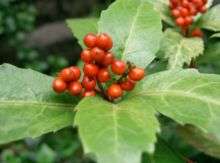Sarcandra glabra
| Sarcandra glabra | |
|---|---|
 | |
| Sarcandra glabra | |
| Scientific classification | |
| Kingdom: | Plantae |
| Clade: | Angiosperms |
| Order: | Chloranthales |
| Family: | Chloranthaceae |
| Genus: | Sarcandra |
| Species: | S. glabra |
| Binomial name | |
| Sarcandra glabra (Thunb.) Nakai | |
| Synonyms | |
|
Sarcandra chloranthoides | |
Sarcandra glabra is an herb native to Southeast Asia. It is also known as Herba Sarcandrae or Glabrous Sarcandra Herb.
Aromatic oils may be extracted from the leaves. The entire plant has anti-stress, antioxidant, anti-inflammatory, detoxifying, blood activating, and anti-bacterial effects.[1][2]
Morphology
Leaf blade elliptic or ovate-lanceolate, 6–17 × 2–6 cm, leathery, margin sharply coarsely-serrate. Stamen baculate to terete; thecae shorter than connective. Stigma subcapitate. Fruit globose, 3–4 mm in diam. Fl. Jun, fr. Aug–Dec.[3]
Distribution
Distributed in Vietnam, Sri Lanka, Taiwan, Cambodia, Malaysia, India, Japan, Korea, the Philippines and mainland China, Jiangxi, Anhui, Fujian, Guizhou, Guangxi, Hunan, Sichuan, Yunnan, Guangdong, Zhejiang and other places, growing at an altitude of 420 meters to 1,500 meters in area, often grown in wet slopes and valleys of the forest shade. It has not yet been cultivated by artificial introduction.
Aliases
"Nine-knotted flower," "bone-knitted lotus."
References
- ↑ He, RR; Yao, XS; Li, HY; Dai, Y; Duan, YH; Li, YF; Kurihara, H (2009). "The anti-stress effects of Sarcandra glabra extract on restraint-evoked immunocompromise". Biol. Pharm. Bull. 32: 247–52. doi:10.1248/bpb.32.247. PMID 19182384.
- ↑ http://www.tcmwiki.com/wiki/zhong-jie-feng
- ↑ Flora of China 4: 132–138. 1999